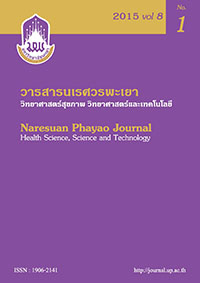โอลิโกแซคคาไรด์ในน้ํานมคน
Keywords:
น้ำนมคน, โอลิโกแซคคาไรด์, พรีไบโอติก, โภชนาการ, human milk, oligosaccharide, prebiotics, nutritionAbstract
น้ำนมคนมีปริมาณโอลิโกแซคคาไรด์มากกว่าน้ำนมโคและน้ำนมแพะ โอลิโกแซคคาไรด์มีโครงสร้าง หลากหลายขึ้นกับมารดาแต่ละคน แลคโตสเป็นสารตั้งต้นของการสังเคราะห์โอลิโกแซคคาไรด์โดยอาศัยเอ็นไซม์นานา ชนิดยกตัวอย่างเช่น เอ็นไซม์ชนิดไกลโคซิลทรานสเฟอเรส ส่วนใหญ่โอลิโกแซคคาไรด์ของน้ำนมไม่สามารถย่อยได้ แต่ สามารถใช้เป็นพรีไบโอติกสําหรับแบคทีเรียลําไส้ กระตุ้นระบบภูมิต้านทาน และป้องกันจุลชีพเกิดโรคนานาชนิด วิธีการใหม่สามารถผลิตสารสังเคราะห์โอลิโกแซคคาไรด์จํานวนมาก เพื่อใช้เสริมอาหารแก่นมผงสูตรดัดแปลงสําหรับ เลี้ยงเด็กอ่อน ผ่านการวิจัยทั้งทางคลินิกและก่อนคลินิก อย่างไรก็ตามนมผงสูตรดัดแปลงสําหรับเลี้ยงเด็กอ่อน และ น้ำนมแพะมีโอลิโกแซคคาไรด์อันมีประโยชน์ไม่มากประเภทและไม่มากคุณภาพเท่ากับน้ำนมคน
Oligosaccharides in human milk
Puksiri Sinchaiyakit*
School of Medical Sciences, University of Phayao, Phayao Province 56000
Human milk oligosaccharides (HMO) are highly abundant in human milk comparing with cow milk and goat milk. The structures of HMO are varied among each mother. Lactose is precursor of oligosaccharide synthesis using various kinds of enzymesuch as glycosyltransferase. Most human milk oligosaccharides are indigestible but they can be used as prebiotic for intestinal bacteria. HMO induces immune system and prevents various kinds of pathogens. The novel methods can produced high amount of synthetic oligosaccharides using for formula-fed milk fortification and other research including clinical and pre-clinical study. However both of the formula-fed milk or goat milk has types and quality of benefit oligosaccharides as not much as human milk.Downloads
Published
How to Cite
Issue
Section
License
ผู้นิพนธ์ต้องรับผิดชอบข้อความในบทนิพนธ์ของตน มหาวิทยาลัยพะเยาไม่จำเป็นต้องเห็นด้วยกับบทความที่ตีพิมพ์เสมอไป ผู้สนใจสามารถคัดลอก และนำไปใช้ได้ แต่จะต้องขออนุมัติเจ้าของ และได้รับการอนุมัติเป็นลายลักษณ์อักษรก่อน พร้อมกับมีการอ้างอิงและกล่าวคำขอบคุณให้ถูกต้องด้วย
The authors are themselves responsible for their contents. Signed articles may not always reflect the opinion of University of Phayao. The articles can be reproduced and reprinted, provided that permission is given by the authors and acknowledgement must be given.








